{UAH} When Kabaka Mutesa's body was returned home
March 31, 1971:
Kabaka Edward Mutesa II's body was returned to Uganda and accorded a decent burial. It is 48 years since that day. To mark the anniversary, we bring you pictures, stories and pages of the 1971 newspaper featuring the return of the fallen king's body, his remains lying in state and the burial at Kasubi tombs.
In 2009, Sunday Vision reprinted copies of the Uganda Argus that covered this historical event. Have a look at these pages of history:
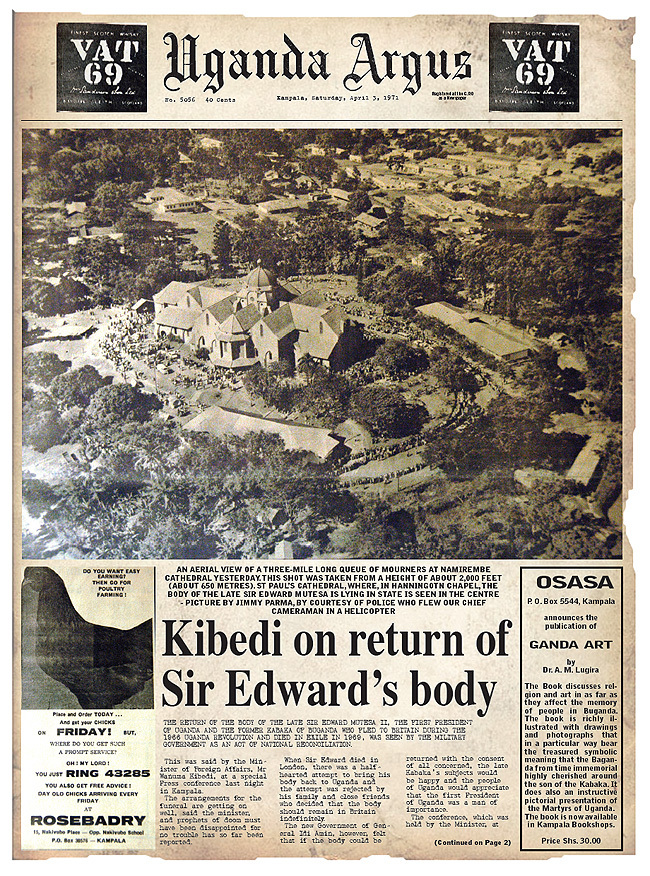
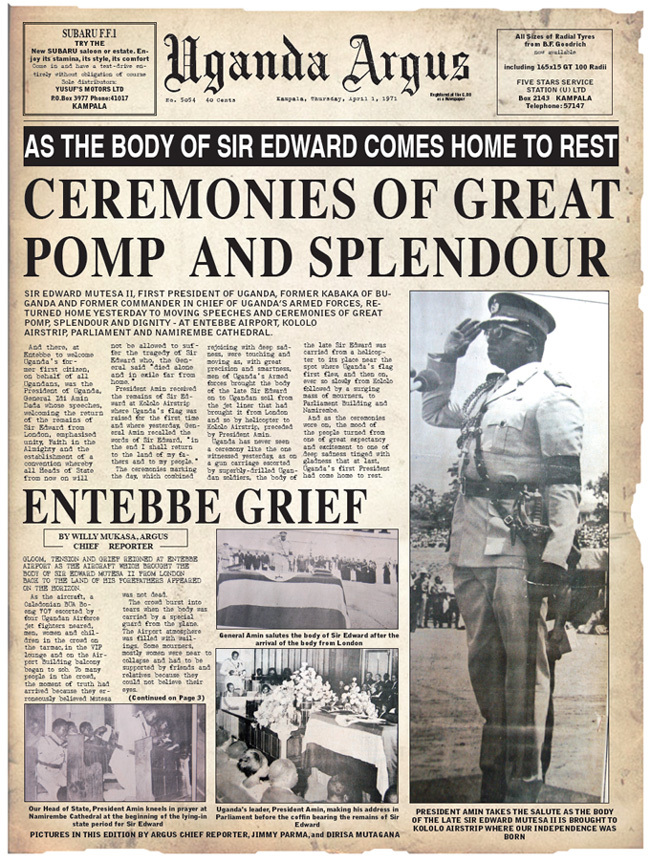


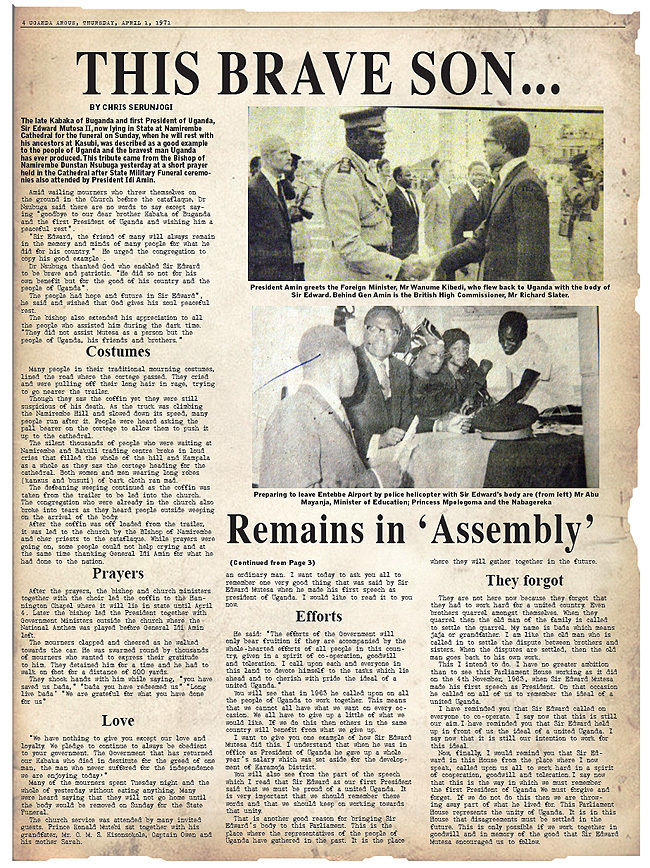
________________________________________
And pictures at Entebbe . . .
It was a mood of gloom, tension and grief at Entebbe Airport as the plane which carried the body of Sir Edward Mutesa II from London back to the land of his forefathers appeared on the horizon.
It was a Caledonian BUA Boeing 707 flight, escorted by four Uganda Airforce jet fighters. As the aircraft come into view, men, women and children in the crowd on the tarmac, in the VIP lounge and on the airport building balcony began to sob. To many people in the crowd, the moment of truth had arrived because they erroneously believed Mutesa was not dead.
The crowd burst into tears when the body was carried by a special guard from the plane. The airport atmosphere was filled with wailings. Some mourners, mostly women, were near to collapse and had to be supported by friends and relatives because they could not believe what they were witnessing.

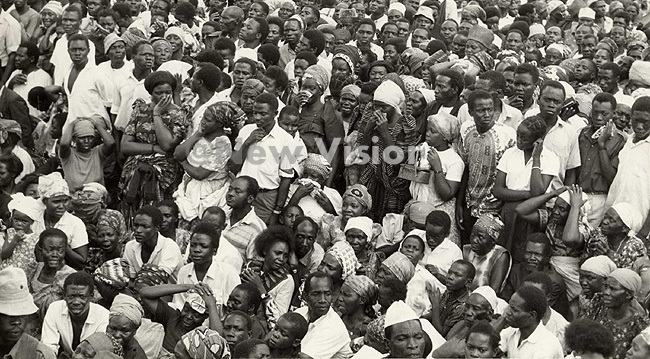
And there, at Entebbe, to welcome Uganda's former first citizen, on behalf of all Ugandans, was the President of Uganda, General Idi Amin Dada. His speeches, welcoming the return of Sir Edward from London, emphasised unity, faith in the Almighty and the establishment of a convention whereby all heads of state from then on not be allowed to suffer the tragedy of Sir Edward, who "died alone and in exile far from home".
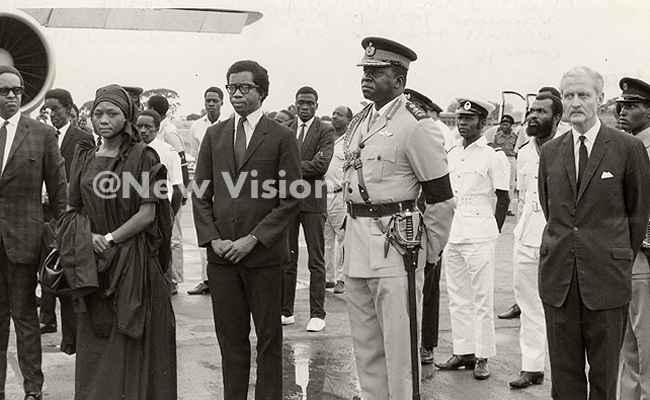
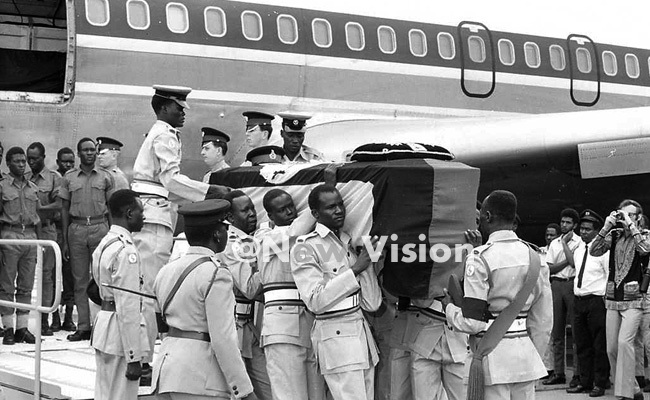
Prince Ronald Mutebi arrives . . .
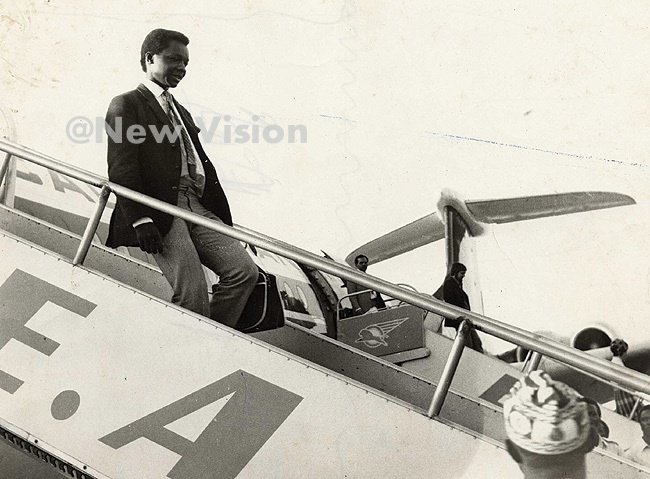
________________________________________
Why President Amin returned Kabaka Mutesa's remains
(This story was first published in Sunday Vision March 29, 2009: Vision Group Resource Centre)
"In the end I shall return to the land of my fathers and to my people." Those were the wistful, at the same time prophetic, words of a heart-broken Sir Edward Mutesa II.
The Kabaka of Buganda and the first president passed away in 1969 in exile in England, where he had fled following the May 24, 1966 attack on his palace at Mengo by government troops, on Prime Minister Apollo Milton Obote's orders.
Mutesa never lived to see the land of his fathers and his people again. But his prophecy and wish came to pass when Gen. Idi Amin, a man who played a key role in Kabaka's eviction from his palace and eventually his kingdom, decided to return the Kabaka's remains home for a state funeral.
"Being a military man, his intelligence team must have informed him that it was important to let the Baganda pay their last respects to their king; if they were to ever support his government," Mayanja Nkangi, who is currently the Chairman of the Uganda Land Commission, told Sunday Vision on Thursday. [Side note: Mayanja Nkangi has since passed on, 1931-2017]
According to Nkangi, Amin wanted to win the hearts of the Baganda so that they support his still new government, which had come into power a few months earlier, on January 25, 1971. Amin got his calculation right.
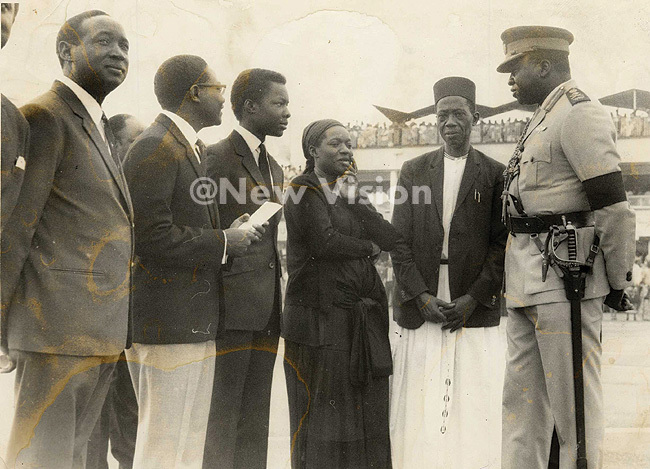 President Amin interacts with the family of Mutesa at Entebbe
President Amin interacts with the family of Mutesa at Entebbe
Although they were fully aware of his role in the attack on the Lubiri, the Baganda readily forgave Amin and for sometime, even supported his government, because he had toppled their number one enemy, Obote, and then returned the body of their beloved Kabaka home for a decent burial.
Nkangi revealed that when Mutesa died, Baganda elders met and agreed not to return his body (enjole), for fear that Obote's government would deny them an opportunity to give it a decent burial.
"We feared that Obote could easily order that the Kabaka's body be flogged. We had to wait for a time when a more tolerable government would take over."
Amin was aware of Buganda's sentiments, and went on to exploit them by returning the Kabaka's body home, personally receiving it at Entebbe Airport.
"When Amin overthrew Obote, there was a lot of jubilation in Buganda," recalled Nkangi, explaining that much as Obote had used Amin as army commander to attack the Kabaka's palace, "the Baganda for the moment forgot their anger towards Amin, to celebrate the demise of Obote's government which had tortured them along with their king".
"The Baganda supported Amin's action to overthrow Obote, but not the man (Amin) himself."
In Nkangi's view, Amin returned Kabaka Mutesa's body "to win Buganda's support for his government".
While it was Amin who took the credit, it was actually Nkangi who initiated the project to return the Kabaka's body home, when he sent the wife of a one Dr. Lwanga, a son of a prominent Muganda elder, to contact Captain Abbas, one of Amin's trusted lieutenants.
"I sent her to Captain Abbas, to request Amin to allow us return the king's remains. Amin agreed," the jovial Nkangi said.
The series of activities that took place from the moment the body arrived in the country to the time it was buried at Kasubi tombs were well documented in the Uganda Argus.
________________________________________
A ceremony never seen before in Uganda
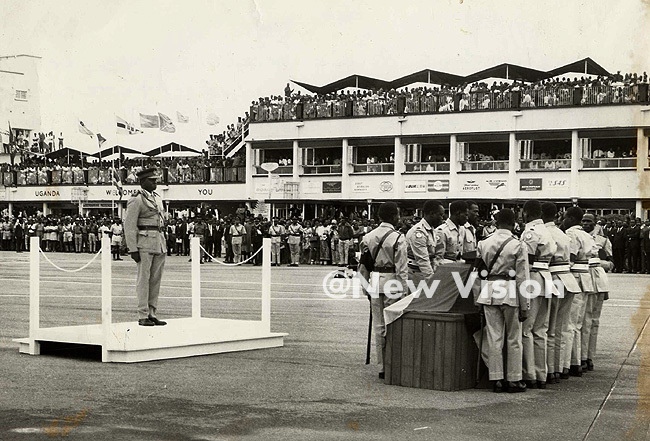
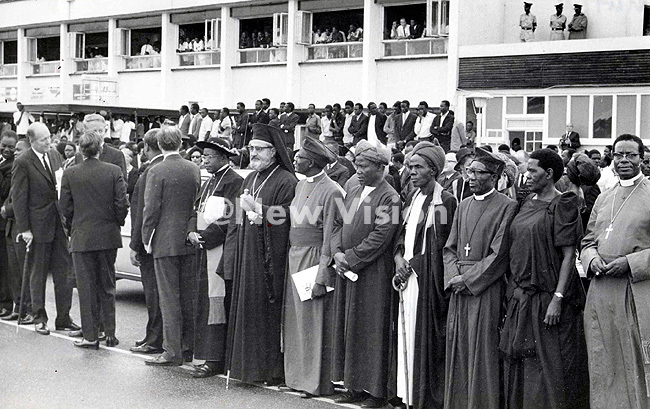
President Amin received the remains of Sir Edward at Kololo Airstrip, where Uganda's flag was raised for the first time and were Amin recalled the words of Mutesa, "in the end I shall return to the land of my fathers and to my people".
The ceremonies marking the day, which combined rejoicing with deep sadness, were touching and moving.
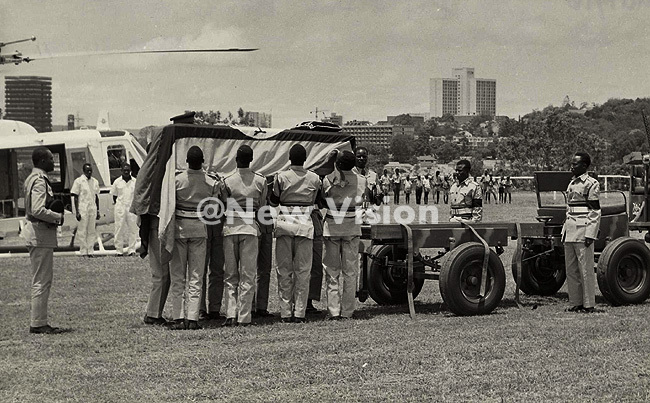
Uganda had never seen a ceremony like the one witnessed when Mutesa was brought back home for burial. On a gun carriage escorted by superbly-drilled Ugandan soldiers, the fallen king's body was carried from a helicopter to its place near the spot where Uganda's flag first flew, and then on, ever so slowly, from Kololo followed by a surging mass of mourners, to Parliament Building and Namirembe.
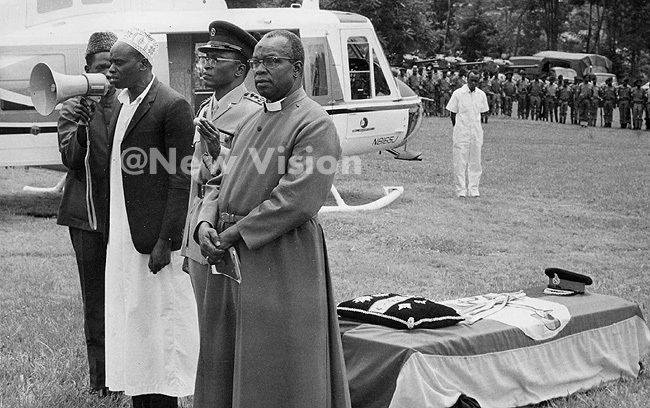
General Amin saluted the body of Sir Edward at Kololo.
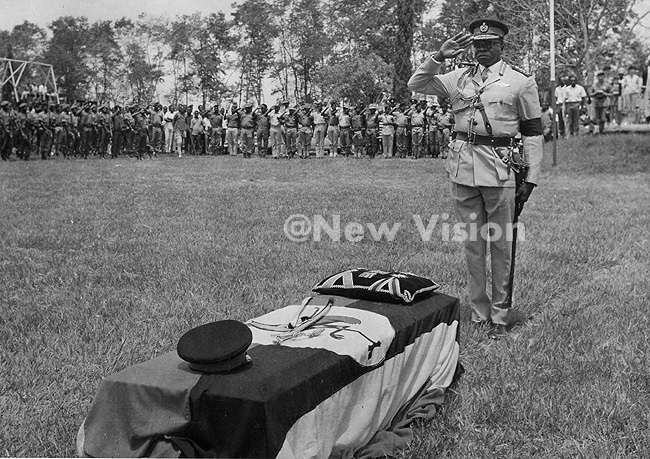
And as the ceremonies wore on, the mood of the people turned from one of great expectancy and excitement to one of deep sadness tinged with gladness that at last, Uganda's first president had come home to rest.

While waiting for the body of Mutesa to be driven from Kololo Airstrip, the crowds, packed between the low walling around the Parliamentary Buildings and the new City Council buildings, and along all roads immediately leading to the Parlimentary Buildings, listened to a running radio commentary amplified around the area.
The general atmosphere among the crowds was tense after they became assured that Sir Edward is dead and not alive as many Baganda had hitherto believed. The jubilant mood, apparently built on disbelief of Mutesa's death, that had been exhibited on lorries travelling to Kasubi even the day before, had virtually been saddened down to tensity as the loud speakers brought through the commentator's voice: "From today, let it be known to everybody that Sir Edward is really dead".
But people burst out into tears when the coffin, covered with the Uganda flag, was driven from Kololo. Many people came dressed in the traditional Kiganda funeral costume - olubugo(bark-cloth) - which might have suggested that they believed Sir Edward's death.
Pictured below is a youthful Ronald Muwenda Mutebi signing in the condolence book . . .
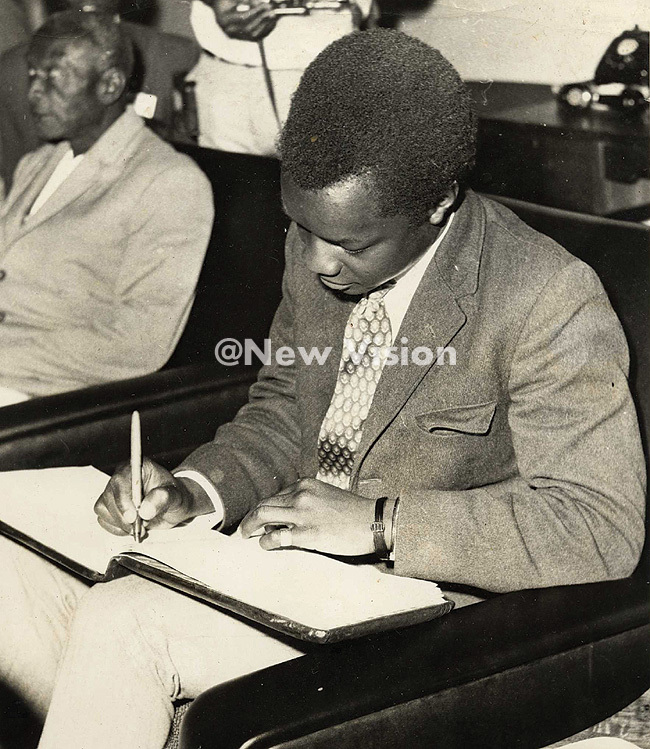
At Parliament . . .
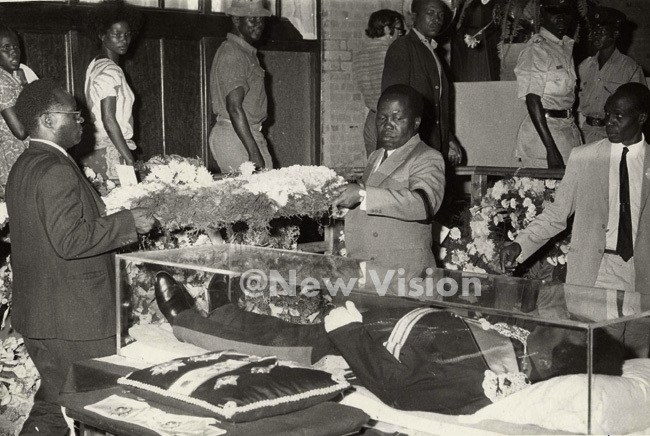
At Rubaga Cathedral . . .
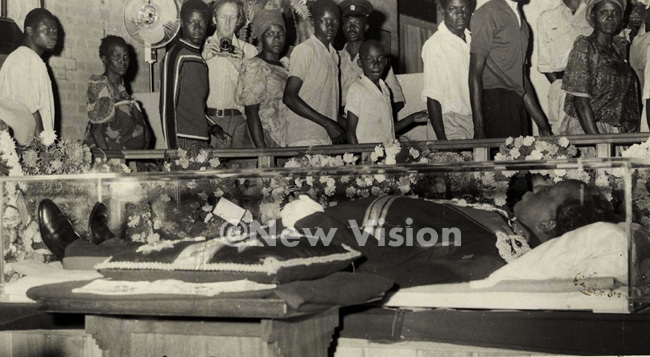
At Namirembe Cathedral . . .
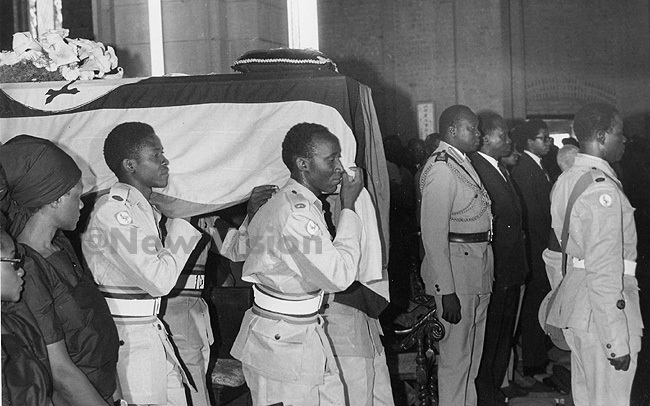
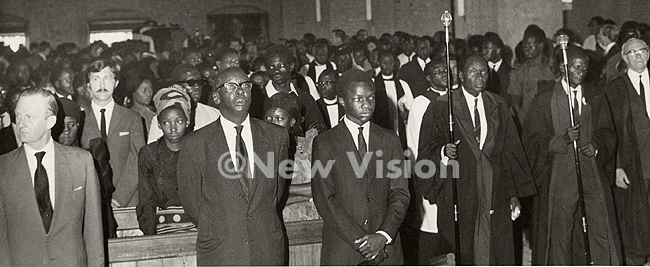
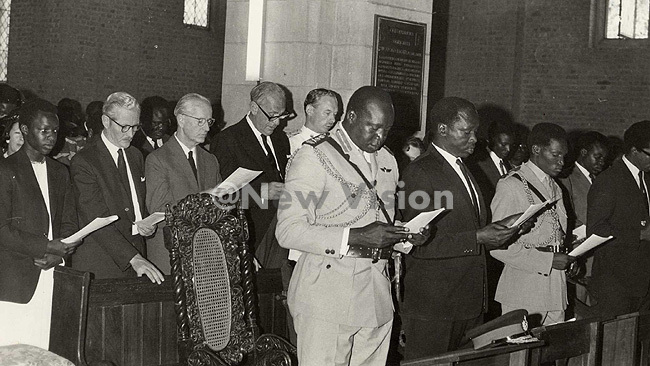
At Kibuli Mosque . . .
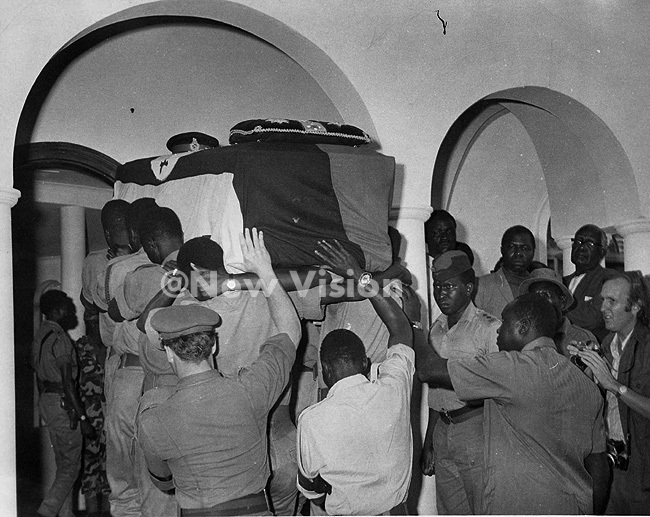

Sir Edward was laid to rest beside his ancestors at the Bassekabaka's tombs at Kasubi near Kampala, amid military pomp and Kiganda funeral rites punctuated with wailings and also cheers praising the president, General Idi Amin for having made funeral possible.
The funeral, which marked the close of an era, the end-time of an unbroken line of 36 Buganda kings starting with the legendary King Kintu, who is believed to have descended from the line of the Lion of Juda, was attended by tens of thousands of mourners, most of them Baganda, many of whom dressed in bark cloths.
Diplomats, ministers and Uganda government officials and representatives of heads of state and governments also attended.
All the die-hard Baganda traditionalists confirmed that Sir Edward had really died when Prince Ronald Mutebi covered a piece of bark cloth on his father's coffin and sat on a small traditional stool known as Kakomera at a ceremony held outside the tombs before the body was taken inside the tombs by the bearer party.
The sitting on Kakomera marks the official succession.
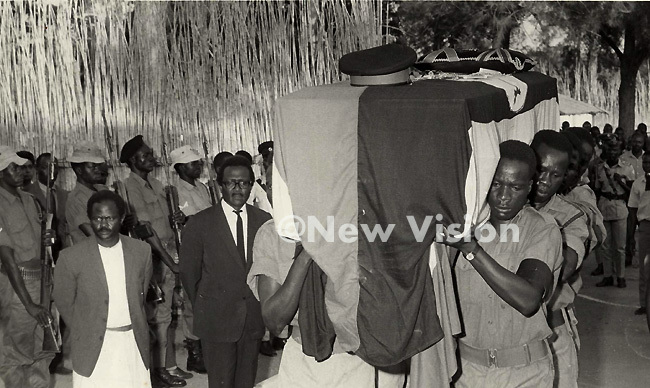
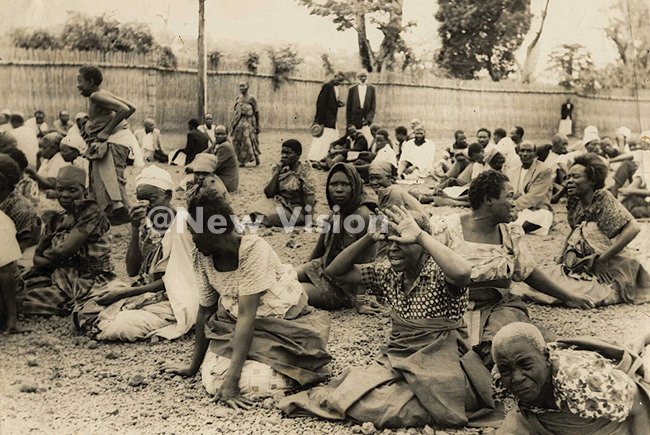
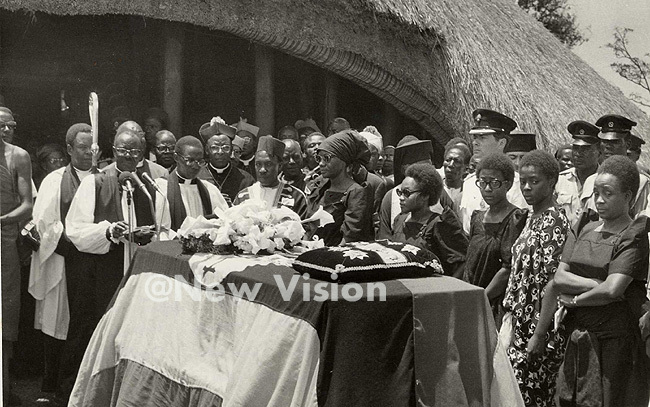
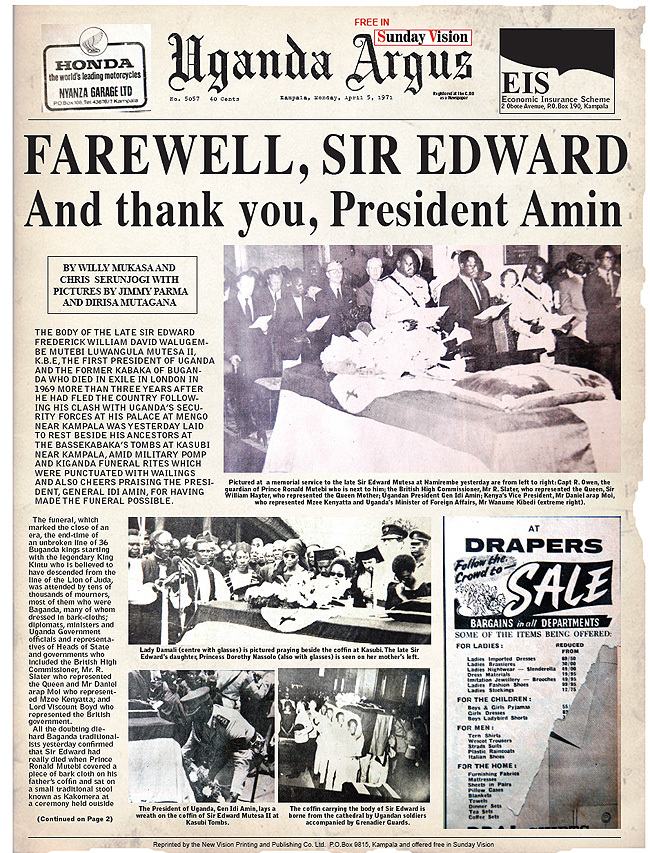
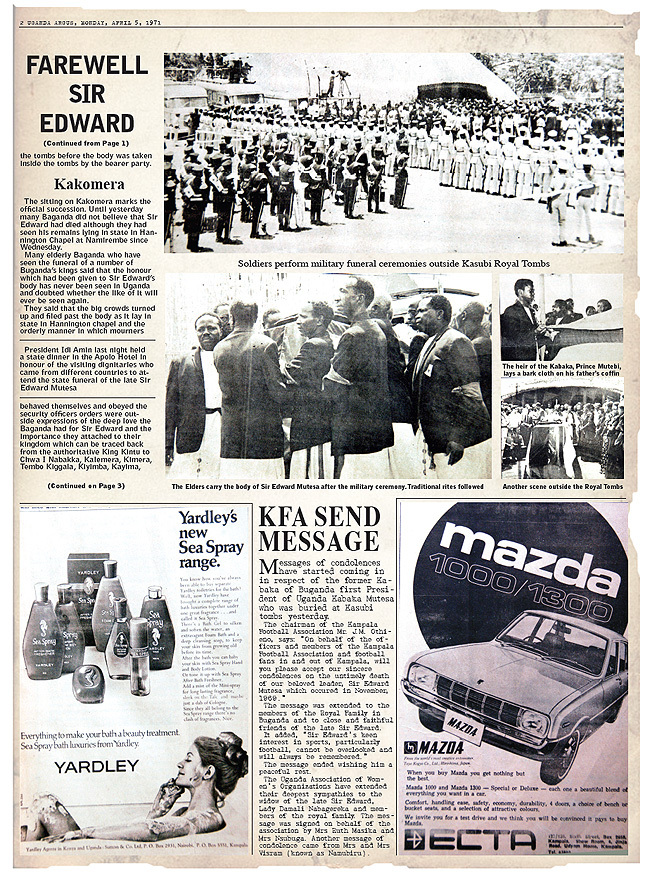
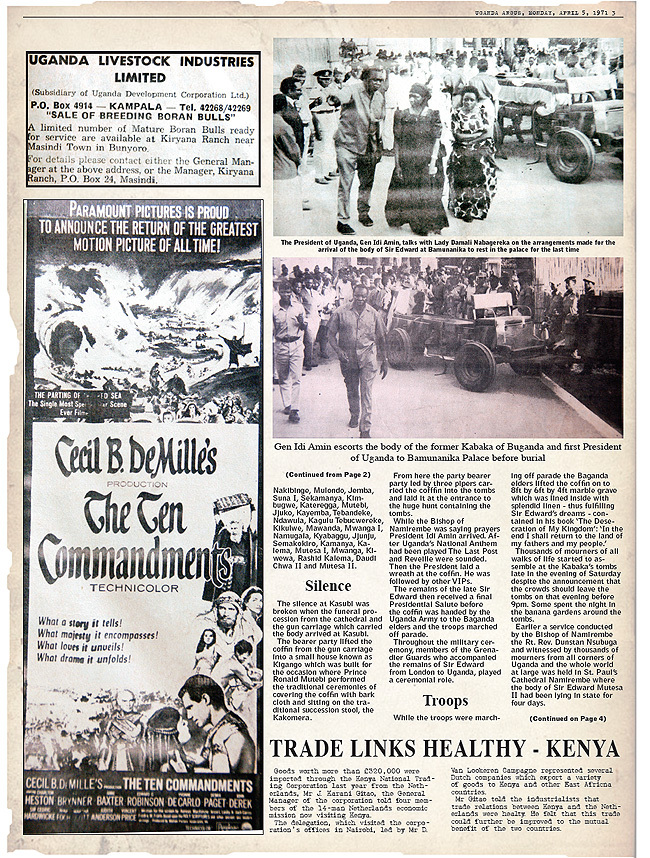
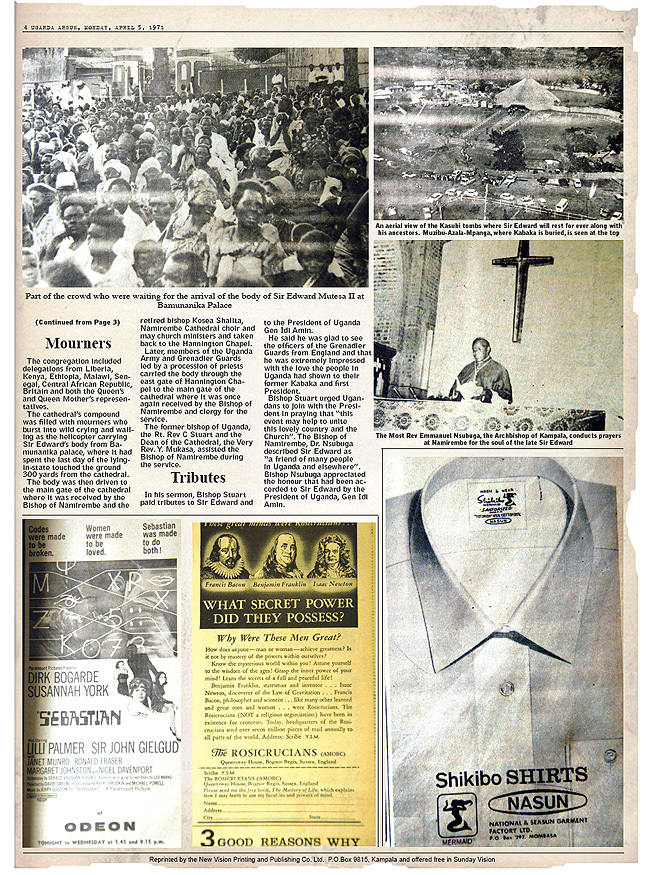
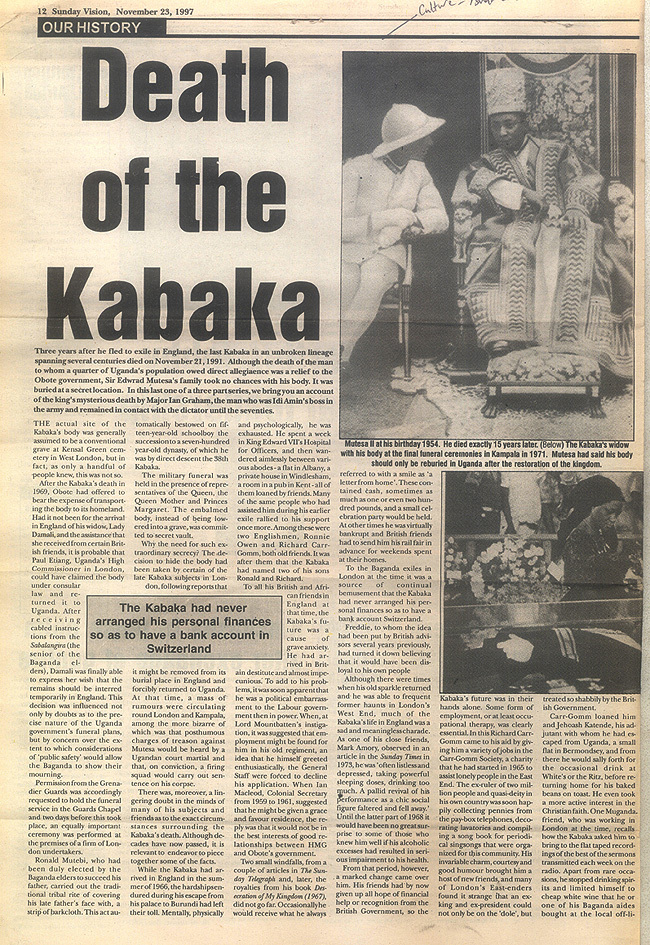
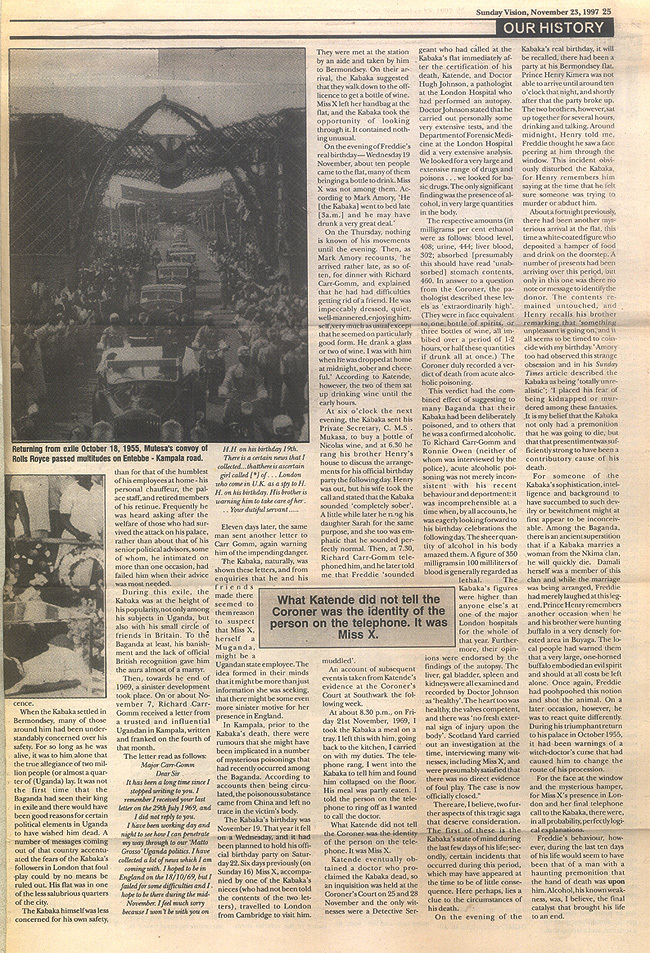
--
-----------------------------------------------------
"To announce that there must be no criticism of the president, or that we are to stand by the president right or wrong, is not only unpatriotic and servile, but is morally treasonable to the American public."
---Theodore Roosevelt
Disclaimer:Everyone posting to this Forum bears the sole responsibility for any legal consequences of his or her postings, and hence statements and facts must be presented responsibly. Your continued membership signifies that you agree to this disclaimer and pledge to abide by our Rules and Guidelines.To unsubscribe from this group, send email to: ugandans-at-heart+unsubscribe@googlegroups.com
---
You received this message because you are subscribed to the Google Groups "Ugandans at Heart (UAH) Community" group.
To unsubscribe from this group and stop receiving emails from it, send an email to ugandans-at-heart+unsubscribe@googlegroups.com.
To view this discussion on the web visit https://groups.google.com/d/msgid/ugandans-at-heart/CAOxg445s3FYxqsvAC%3DaKnn3DnKGB6AsSURheu4-oCULftOsLLg%40mail.gmail.com.






0 comments:
Post a Comment